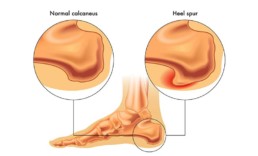Do you suffer from heel pain? If so, you’re not alone. Unfortunately, many people try to ignore the early signs of heel pain and keep on doing the activities that caused it. When you continue to use a sore heel, it will only get worse and could become a chronic condition leading to more problems.
It shouldn’t hurt to get to your feet in the morning or walk throughout the day. If you notice a sharp, stabbing sensation in your heel with each step you take, you may be suffering from heel spurs.
How do you know if you have a heel spur?
Heel spurs develop over time; they don’t magically appear. Repetitive strain on your muscles and ligaments in the foot and heel can lead to a heel spur, a bony buildup of calcium on the heel that can form and cause pain.
There are two types of heel spurs: an inferior calcaneal spur, which results from ongoing stress to the bottom of the heel and grows between the heel and the arch of the foot; and a posterior calcaneal spur, which is the result of repeated trauma to the back of the heel where the Achilles tendon is attached.
The posterior calcaneal type of heel spur is often visible to the eye and can be easily felt, but the inferior calcaneal spur is trickier to diagnose, because the pain it causes can be mistaken for plantar fasciitis.
Generally, an X-ray is required to ascertain that a heel spur is, indeed, the cause of the pain you are experiencing.
What causes heel spurs?
Common causes for heel spurs include heel bruising, arthritis, shoes that fit poorly, the effects of excess weight, footwear with minimal support (e.g., flipflops) and gait issues that put too much pressure on the heel bone and surrounding ligaments and nerves.
Aging can also be a contributing factor, because the plantar fascia become less flexible and the heel padding becomes thinner. Flat feet or high arches may also lead to heel spurs, as can diabetes or work that requires you to spend most of the day on your feet.

Heel Spur vs Plantar Fasciitis
Heel spurs often co-exist with cases of plantar fasciitis. The plantar fascia are the fibrous tissues that run from the heel to the ball of the foot and inflammation of these tissues is called plantar fasciitis. However, plantar fasciitis can be cured, but once heel spurs develop, they remain in place, although their impact can be minimized.
Heel spur sufferers may experience a sharp, knifelike pain when they stand up; the pain generally lessens and becomes a dull ache. You may feel heat radiating from the area and see inflammation and swelling.
Walking barefoot may be difficult due to tenderness at the bottom of the heel. Often, the heel spur itself is not the cause of the pain; the pain comes from the injury underlying it.
Can a heel spur go away on its own?
As mentioned, heel spurs may be easily confused with plantar fasciitis, so your physician will generally request an X-ray before making a diagnosis. Heel spurs don’t dissolve or disappear, but you can mitigate the pain and discomfort they generate.
How to relieve heel spur pain
Your physician may suggest one or more possibilities to relieve heal spur pain. The easiest is the use of over-the-counter pain medications, such as ibuprofen, acetaminophen or naproxen. Icing your heel will also help reduce any swelling or inflammation.
Heel spur exercises
Physiotherapy is another useful option. Your physiotherapist will do an analysis of your gait and can prescribe a course of exercises that will help correct any imbalances that allow your heel spurs to grow. They may also use a combination of manual therapy and ultrasound to break down calcification. Acupuncture may also be employed to help reduce pain. To reduce the stress on your foot’s muscles and tendons, your physiotherapist may use strapping or taping techniques in the area.
Orthotics for heel spurs
Your physician or physiotherapist may also prescribe custom orthotics, inserts that are placed in your shoes to assist in correcting your gait and suggest that you wear cushioned sports shoes to alleviate pain.Custom orthotics often have a well cut in them to provide extra cushioning to the affected area to reduce the impact of walking or being active on your heel.
How long does a heel spur last?
Most sufferers of heel spurs recover from the pain and discomfort with nonsurgical treatments. However, if the discomfort persists after nine to 12 months, surgery may be necessary.
Remember: a heel spur is a chronic condition, so it will be up to you to manage it. By following your physician’s recommendations and doing the exercises prescribed by your physiotherapist, you should eventually be able to forget that they exist.
